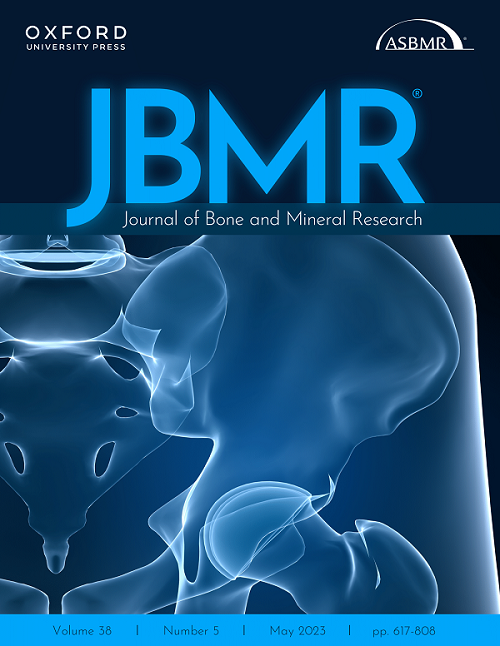Alex Shoung, Nicholas Shoung, Rachael Hii, Nitesh Nerlekar, Peter R Ebeling, Alexander J Rodríguez
下载PDF
{"title":"双膦酸盐静脉输注后的心电图变化:系统综述和荟萃分析。","authors":"Alex Shoung, Nicholas Shoung, Rachael Hii, Nitesh Nerlekar, Peter R Ebeling, Alexander J Rodríguez","doi":"10.1002/jbmr.4911","DOIUrl":null,"url":null,"abstract":"<p>Bisphosphonates are first-line treatments for several bone and mineral disorders. Studies have reported an increased incidence of serious atrial fibrillation in patients receiving bisphosphonates; however, uncertainty remains as to whether electrical disturbances are precipitated by bisphosphonates. We aimed to review the literature for studies reporting electrocardiogram (ECG) findings in patients receiving intravenous bisphosphonates for any indication. We searched MEDLINE and EMBASE from inception until January 14, 2023, for studies reporting ECG parameters after intravenous bisphosphonate infusion. We excluded studies that only reported atrial fibrillation. Study quality was assessed using the Newcastle-Ottawa scale. Continuous data were meta-analyzed if reported in at least two studies. Random-effects models were fitted and reported as standardized mean difference (SMD) with 95% confidence intervals (95% CIs). We found 1083 unique records, of which 11 met our inclusion and exclusion criteria. Studies had a low to low/moderate risk of bias. Six prospective cohort studies were included in the meta-analysis. Five studies used zoledronic acid, whereas one study used pamidronate. Most studies (<i>n</i> = 4) were conducted in postmenopausal women with osteoporosis, one study was conducted in patients with bone metastases, and one study in children with osteoporosis secondary to cerebral palsy. Study populations ranged from <i>n</i> = 15 to <i>n</i> = 116. Heart rate–corrected QT (QTc) was significantly longer post-infusion (SMD = 0.46 ms [95% CI 0.80 to 0.11]; <i>n</i> = 67 patients, <i>k</i> = 2 studies, <i>τ</i><sup>2</sup> = 0). There were no differences in heart rate, P wave (maximum), P wave (minimum), P wave dispersion, PR interval, QRS duration, QTc, QTc (maximum), QTc (minimum), and QTc dispersion. The correlation between pre- and post-infusion QTc was not significant (<i>p</i> = 0.93). Overall, there is a weak association between intravenous bisphosphonate infusion and a QTc interval prolongation. However, there is insufficient evidence to support an association between intravenous bisphosphonate and any ECG variable changes, which may precipitate atrial fibrillation. © 2023 The Authors. <i>Journal of Bone and Mineral Research</i> published by Wiley Periodicals LLC on behalf of American Society for Bone and Mineral Research (ASBMR).</p>","PeriodicalId":185,"journal":{"name":"Journal of Bone and Mineral Research","volume":"38 11","pages":"1679-1688"},"PeriodicalIF":5.1000,"publicationDate":"2023-09-08","publicationTypes":"Journal Article","fieldsOfStudy":null,"isOpenAccess":false,"openAccessPdf":"https://asbmr.onlinelibrary.wiley.com/doi/epdf/10.1002/jbmr.4911","citationCount":"0","resultStr":"{\"title\":\"Electrocardiogram Changes Following Intravenous Bisphosphonate Infusion: A Systematic Review and Meta-Analysis\",\"authors\":\"Alex Shoung, Nicholas Shoung, Rachael Hii, Nitesh Nerlekar, Peter R Ebeling, Alexander J Rodríguez\",\"doi\":\"10.1002/jbmr.4911\",\"DOIUrl\":null,\"url\":null,\"abstract\":\"<p>Bisphosphonates are first-line treatments for several bone and mineral disorders. Studies have reported an increased incidence of serious atrial fibrillation in patients receiving bisphosphonates; however, uncertainty remains as to whether electrical disturbances are precipitated by bisphosphonates. We aimed to review the literature for studies reporting electrocardiogram (ECG) findings in patients receiving intravenous bisphosphonates for any indication. We searched MEDLINE and EMBASE from inception until January 14, 2023, for studies reporting ECG parameters after intravenous bisphosphonate infusion. We excluded studies that only reported atrial fibrillation. Study quality was assessed using the Newcastle-Ottawa scale. Continuous data were meta-analyzed if reported in at least two studies. Random-effects models were fitted and reported as standardized mean difference (SMD) with 95% confidence intervals (95% CIs). We found 1083 unique records, of which 11 met our inclusion and exclusion criteria. Studies had a low to low/moderate risk of bias. Six prospective cohort studies were included in the meta-analysis. Five studies used zoledronic acid, whereas one study used pamidronate. Most studies (<i>n</i> = 4) were conducted in postmenopausal women with osteoporosis, one study was conducted in patients with bone metastases, and one study in children with osteoporosis secondary to cerebral palsy. Study populations ranged from <i>n</i> = 15 to <i>n</i> = 116. Heart rate–corrected QT (QTc) was significantly longer post-infusion (SMD = 0.46 ms [95% CI 0.80 to 0.11]; <i>n</i> = 67 patients, <i>k</i> = 2 studies, <i>τ</i><sup>2</sup> = 0). There were no differences in heart rate, P wave (maximum), P wave (minimum), P wave dispersion, PR interval, QRS duration, QTc, QTc (maximum), QTc (minimum), and QTc dispersion. The correlation between pre- and post-infusion QTc was not significant (<i>p</i> = 0.93). Overall, there is a weak association between intravenous bisphosphonate infusion and a QTc interval prolongation. However, there is insufficient evidence to support an association between intravenous bisphosphonate and any ECG variable changes, which may precipitate atrial fibrillation. © 2023 The Authors. <i>Journal of Bone and Mineral Research</i> published by Wiley Periodicals LLC on behalf of American Society for Bone and Mineral Research (ASBMR).</p>\",\"PeriodicalId\":185,\"journal\":{\"name\":\"Journal of Bone and Mineral Research\",\"volume\":\"38 11\",\"pages\":\"1679-1688\"},\"PeriodicalIF\":5.1000,\"publicationDate\":\"2023-09-08\",\"publicationTypes\":\"Journal Article\",\"fieldsOfStudy\":null,\"isOpenAccess\":false,\"openAccessPdf\":\"https://asbmr.onlinelibrary.wiley.com/doi/epdf/10.1002/jbmr.4911\",\"citationCount\":\"0\",\"resultStr\":null,\"platform\":\"Semanticscholar\",\"paperid\":null,\"PeriodicalName\":\"Journal of Bone and Mineral Research\",\"FirstCategoryId\":\"3\",\"ListUrlMain\":\"https://onlinelibrary.wiley.com/doi/10.1002/jbmr.4911\",\"RegionNum\":1,\"RegionCategory\":\"医学\",\"ArticlePicture\":[],\"TitleCN\":null,\"AbstractTextCN\":null,\"PMCID\":null,\"EPubDate\":\"\",\"PubModel\":\"\",\"JCR\":\"Q1\",\"JCRName\":\"ENDOCRINOLOGY & METABOLISM\",\"Score\":null,\"Total\":0}","platform":"Semanticscholar","paperid":null,"PeriodicalName":"Journal of Bone and Mineral Research","FirstCategoryId":"3","ListUrlMain":"https://onlinelibrary.wiley.com/doi/10.1002/jbmr.4911","RegionNum":1,"RegionCategory":"医学","ArticlePicture":[],"TitleCN":null,"AbstractTextCN":null,"PMCID":null,"EPubDate":"","PubModel":"","JCR":"Q1","JCRName":"ENDOCRINOLOGY & METABOLISM","Score":null,"Total":0}
引用次数: 0
引用
批量引用


 求助内容:
求助内容: 应助结果提醒方式:
应助结果提醒方式:


